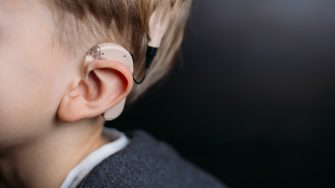Making progress with peripheral nerve interfaces
How UNSW engineers are redesigning technology to help treat and diagnose chronic pain and illness.
How UNSW engineers are redesigning technology to help treat and diagnose chronic pain and illness.

There are many neuroprosthetic devices already in use today – from the cochlear implant, to deep brain stimulators (DBS) that can restore mobility in people with Parkinson’s disease. These devices target the central nervous system via the brain. While peripheral nerve implants share many of the same technologies and properties as implants used in the brain, there are significant anatomical differences – imposing both new challenges and design opportunities.
A team at UNSW – including David Tsai, Mohit Shivdasani and Laura Poole-Warren – are working to develop new ways forward for peripheral nerve interfaces. From tissue compatibility to new devices to treat inflammatory bowel diseases, their work is diverse in application but united in its intent: to make a positive difference towards health conditions impacting countless people around the world.
Redesigning peripheral nerve interfaces offers promising advancements in the treatment and diagnosis of neuropathic pain in a range of ways. This includes enhanced precision for nerve stimulation, with modern designs more capable of targeting specific nerve fibres involved in neuropathic pain – and even adapting to real-time feedback from the nerve, for a more personalised treatment for individual pain levels.
Diagnosis and monitoring can also be improved. Redesigned interfaces can collect data in real time to better understand the underlying mechanisms of neuropathic pain. Furthermore, incorporating these interfaces into wearable devices makes it easier to monitor nerve function and pain levels. Engineers are also redesigning interfaces to better integrate with other therapies – such as drug delivery systems or cognitive-behavioural therapies, for a more holistic, personalised treatment plan.
At its core, neural engineering seeks to enhance “brain”-computer interactions and expand the capabilities of neural prosthetics. The work being done at UNSW has the potential to create more advanced technology solutions for neurological and other disorders.
For David Tsai, the focus is on developing advanced electronic technologies so that neural interfaces can better decode and interpret neural signals. This includes creating softer electrode materials and designs to improve data quality and tissue compatibility – and exploring ways to integrate interfaces with AI and machine learning.
Mohit Shivdasani’s key areas are two-fold. One is the development of a biocompatible microfluidic peripheral nerve interface that can deliver a special form of current known as ionic direct current – which can block pain signals to the brain. The second area involves developing a new generation of implantable sensors to measure and treat symptoms of inflammatory bowel disease.
Laura Poole-Warren is known for her contributions to the field of neural interfaces – and her current research aims to develop new materials which can optimise the interface between neural tissue and the electrode – which can improve signal quality and reduce issues such as signal degradation or noise. Since the human body is one of the most aggressive environments for a foreign device, Laura’s expertise in preclinical evaluation of material and device performance has helped us understand how to minimise inflammatory response and improve the longevity of implanted devices.
Laura says, “our vision is to develop the technology that can meet the needs of people with disabilities and/or loss of sensory or motor function (see quote below). Higher resolution devices that are softer and smaller are required for a step change that can improve therapies in this field."
Not only this, personalised closed-loop bioelectronic devices will will make it more possible to conduct measurements (diagnosis) at the same time as initiating treatment (therapy). “It’s often said that ‘you can’t treat effectively what you can’t measure,’” says Laura. "Our hope is that being able to measure and treat some key applications will inspire a new generation of devices at for personalised medicine."
As our population ages, so does the prevalence of conditions like diabetes, inflammatory diseases and chronic pain have increased as the population ages. It’s in developing tools and technologies that can improve people’s lives and provide better health outcomes that drives the team at UNSW – and the fearless thinking they apply to biomedical engineering every day.
As Australia’s best engineering faculty turns 75, there are just as many reasons why we’ve earned that title. Discover new stories weekly, celebrating the successes that have enabled progress for all.